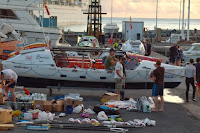''According to figures released yesterday by airports authority AENA, December saw over a million foreign visitors to the Canaries.
14.01.2014 - In total, 1,063,844 tourists flew into the archipelago, 124,239 more than in the previous year, an increase of 13.22 per cent. During the year, 10,591,260 passengers entered the Islands via the airports, 4.85 per cent up on 2012 – almost half a million more tourists.
 The Deputy Minister for tourism in the Canaries Ricardo Fernández de la Puenta underlined that, “these figures confirm the good condition of the tourism sector in the last quarter of the year…Provisions in the sector indicate that this tendency will continue.”
The Deputy Minister for tourism in the Canaries Ricardo Fernández de la Puenta underlined that, “these figures confirm the good condition of the tourism sector in the last quarter of the year…Provisions in the sector indicate that this tendency will continue.”
By islands:Tenerife saw an increase of 10.06 per cent in December, five per cent over the year; Lanzarote received 19.99 per cent, 9.77 per cent over 2012, Gran Canaria has 13.71 per cent more visitors in December, and an increase of 4.87 per cent in the year; Fuerteventura 14.38 per cent and 0.73 per cent more respectively and La Palma an increase of 3.9 per cent and 13.89 per cent over the whole of 2012. ''










.jpg)






























